January 24, 2020 | By Hope Weil. . .
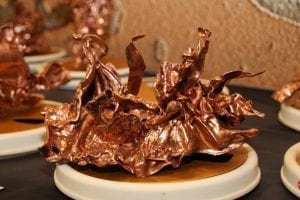
On January 14, The University of South Florida’s College of Marine Science held the Think Macro Act Micro event at USFSP.
The event was held to showcase artwork created by area artists in response to Art and Science Night. In mid-November, 29 artists from around Tampa Bay came to the USF College of Marine Science to learn about current research activities and get some hands-on inspiration.
“The artists rotated through five different lab groups and activities, including biology, chemistry and geology,” explains Mya Breitbart, a College of Marine Science Professor who helped put together the event.
Artists were given the opportunity to view live plankton under microscopes, create paintings using colored bacteria, witness the scanning and transmission of electron microscopes and learn about trace metal chemistry and geology. The event was small and immersive and allowed artists to get hands-on-experience and talk closely with scientists.
“Our goal. . . was to have something of interest for everyone, and to showcase the cutting-edge research being performed right here at USF in a fun, accessible manner,” says Breitbart.
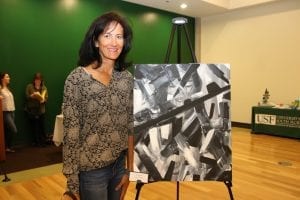
“In my view, one of the most important parts of the event was the chance for the artists to meet and interact with scientists — to see that these are enthusiastic members of our own community who are extremely passionate about their research and its goals. I think it’s very easy to think about science as something that is inaccessible, very formal and serious — and being done elsewhere.”
The Think Macro Act Micro ended up with 18 artists creating work in a variety of styles. The event drew in a large crow of attendees of all different backgrounds.
Many unique pieces of art were on display at the event including ceramics, oil and acrylic canvases, sculptures and even a live performance.

One artist, John Gurbacks, showcased three pieces at the event. Gurbacks has worked full-time as an artist since the 1980s. “I think that it is important to address important issues that relate to the environment [in artwork],” he says. One of his oil on canvas paintings, Fender Bender, depicted a car smashing into several sea creatures. He says that the car in his painting depicts the breakdown of technology. Another one of his paintings, which was untitled, showcased glaciers and presumably the bottom of the ocean, but he says that part is up to the interpretation of the viewer.
“Artists have their own motivations, but artwork becomes a visual medium for its viewers,” says Gurbacks.
Another artist that had work showcased at the event was Rebekka Huneke. “I went to the discovery night back in November and I really enjoyed going through all the different labs that they had open to us,” says Huneke. “The last lab that we went to had huge magnifying glasses and they had big zoomed-in pictures of all the different creatures. Usually I do really micro ‘small art’ but this time I changed it up.”
 Huneke ended up painting an octopus for the event that took up three different canvases which she mounted together. “I wanted to do something a little different and I love cephalopods,” she explains. “Cephalopods are having an issue in the ocean right now and so I wanted to bring awareness to that.” Huneke says.
Huneke ended up painting an octopus for the event that took up three different canvases which she mounted together. “I wanted to do something a little different and I love cephalopods,” she explains. “Cephalopods are having an issue in the ocean right now and so I wanted to bring awareness to that.” Huneke says.
The art showcased at the event was not allowed to be sold at the event, but artists were encouraged to give out their business cards to interested parties.
Breitbart said that her lab’s outreach coordinator, Makenzie Burrows, was the driving force behind Think Macro Act Micro. “Beyond saying ‘I want us to run a science-art collaboration event,’ she really took the reins and designed and executed all aspects of the event,” explains Breitbart.
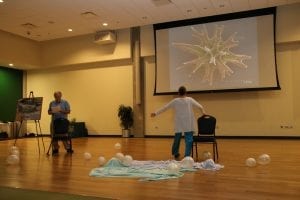
Due to the success of both events, the department hopes to do something similar in the future. “We are having an event recap meeting later this week to discuss the format of the event and things we would like to implement in the future,” says Mya Breitbart. “For me, the success of these events confirmed my beliefs that we need to open our labs to the public more and give them a chance to see where our blood, sweat and tears are going.”
A special aspect of the USF College of Marine Science is that they are performing interdisciplinary research. “Meaning that instead of having biologists, chemists, physicists and geologists all working in their individual research silos, we are combining these specialties to create an integrative understanding of how our oceans work,” Breitbart explains.
Participating Artists
. . .
Bob Barancik
Donald Gialanella
Paul Glass
John Gurbacs
Julie Haura
Rebekka Huneke
Paula Kramer, Sheila Cowley
and Jim Rayfield
[Disclaimer – Sheila Cowley is the
Managing Editor of the Arts Coast Journal]
Machelle Knochenhauer
Denise Lange
Elizabeth Nygaard
Tony Palms
Antonio Permuy
Jamie Williams
Don Gialanella
Emiliania Huxleyi

Steel transmission parts, rebar. 50″ tall, 2020
Inspired by seeing the phytoplankton, Emiliania Huxleyi, under the microscope, this eclectic sphere is composed of dozens of transmission gears welded together.
It is a sculptural interpretation of a beautifully intriguing tiny marine organism that forms the basis of the global food chain.
The sphere is the perfect shape as all points on the surface are the same distance from the center. Atoms, planets, the sun and our earth are all spheres, and of course, so are some tiny plankton.
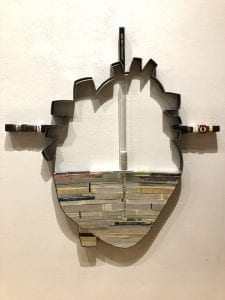
Tony Palms
Island of Knowledge
This piece is made from books and metal welded into the shape of a human heart.
The title is from a book, The Island of Knowledge: The Limits of Science and the Search for Meaning by Marcelo Gleiser. Gleiser is a theoretical physicist and professor of physics and astronomy at Dartmouth College. His book explores fundamental questions of existence.
This I feel all science directly or indirectly expresses, and all art on some level. And no doubt each human being at some point faces fundamental questions of identity, existence and meaning.
The piece primarily references marine geology, where scientists take core samples of the ocean floor and from these core samplings, find traces and evidence of how things evolved, changed and developed to this current state.
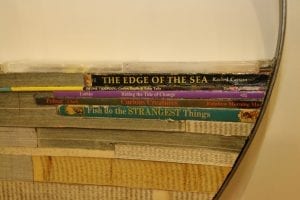
The top of the piece is a book titled Into the Unknown which is the beginning of exploration, of experiments, based on whatever questions and hypothesis the scientist feels necessary or important to research. Cross-sections of nonfiction books, fiction and poetry represent layers of the ocean floor. Most have the titles hidden, just the edges of the pages visible. Titles you can see include Ann Morrow Lindbergh’s Gift from the Sea, Billy Collins’ The Art of Drowning, 20,000 Leagues Under the Sea, Fish do the STRANGEST Things, The Incredible Water Show and The Odyssey.
Depth of the ocean to depth of the heart. A simple analogy of two unknowns.
An interesting point Marcelo Gleiser presents is that as the island of knowledge grows, so do the shores of our ignorance.
My understanding is that from this ignorance comes greater questions which promote further research and exploration.
Find out more about the cutting-edge Marine Science
research taking place at USFSP here
More on this event from the Marine Science Department
Photos by Dana Nieuwkerk


